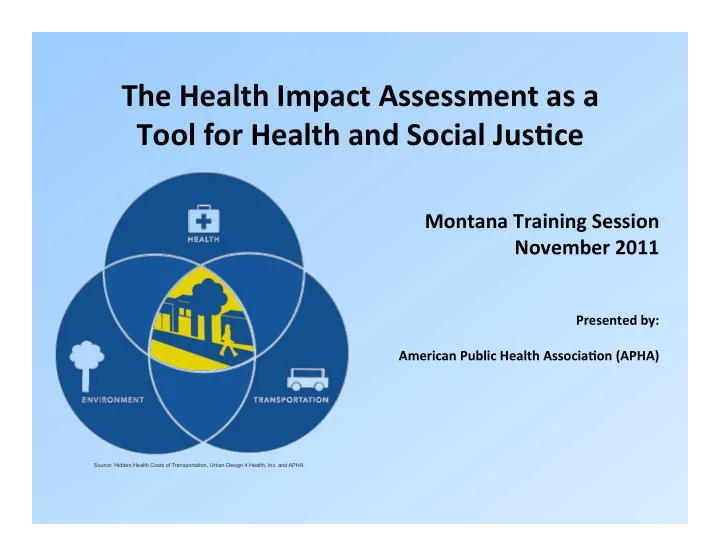

The Health Impact Assessment as a Tool for Health and Social Jus8ce Montana Training Session November 2011 Presented by: American Public Health Associa8on (APHA) Source: Hidden Health Costs of Transportation, Urban Design 4 Health, Inc. and APHA.
How Policy Impacts Health Source: Hidden Health Costs of Transportation, Urban Design 4 Health, Inc. and APHA.
What can HIAs do? • Address the root causes of health problems in a community • Help decision‐makers in non‐health sectors integrate health into proposed projects, policies • Suggest miBgaBons to avoid health impacts and inequiBes
(Scalable) HIA Process Health Impact Assessment (HIA): a systemaBc process to make evidence‐based judgments on the health impacts of decisions and/or policies HIA Steps What’s Involved Screening Determine need for and value of a HIA Scoping Determine which health impacts to evaluate, methods for analysis, data needs to complete the assessment Assessment Evaluate magnitude of potenBal health impacts and idenBfy miBgaBon strategies and recommendaBons Repor8ng Communicate results to stakeholders and decision‐makers Monitoring/ Track effects of the HIA and decisions on health Evalua8on
Rapidly Emerging across Diverse Sectors Housing, Employment, Educa8on, Environment, Transporta8on… • Paid Sick Days ‐ MassachuseNs • Living Wage Ordinance – Los Angeles • Safe Routes to School ‐ Sacramento • Cap & Trade – California • County agricultural plan – Hawaii • Coal gasificaBon plant – Kentucky • Farm‐to‐School – Oregon • Light rail transit line – Minnesota • Land use planning – Albuquerque • Gender pay equity legislaBon – Detroit • PotenBal ModificaBons to Physical EducaBon Requirements ‐ California • Low Income Home Energy Assistance Program ‐ MassachuseNs Photo credits: chrisroll, simon howden, paul mar5n eldridge, chokphoto
Broad CollaboraBon in HIAs • Public health agencies • Community organizaBons • Advocacy groups • Researchers • Academics • Planning, regulatory and other agencies • Elected officials • Private industry and developers
HIAs Completed or In Progress (~120) WA 8 ME 1 MT 2 MN 6 NH 2 OR 12 WI 1 MA 4 PA 2 OH 1 IL 1 NJ 1 CO 4 CA MD 2 KY 1 48 MO 1 TN 1 NM 1 GA 8 TX 1 FL AK 7 1 HI 1 Map Courtesy of A. Dannenberg, A. Wendel (CDC NCEH)
TransportaBon‐specific HIAs Road and Bridge Redevelopments Community Transporta8on Plans Columbia River Crossing (Portland) City of Decatur Community TransportaBon Plan I‐280 SBll/Lyell Freeway (SF) City of Spokane Downtown Plan Update SR520 Bridge (SeaNle) Clark County Bicycle and Ped Master Plan Treasure Island Community Transp Plan Public Transit Atlanta Beltline Corridor Redevelopment BalBmore Red Line St. Paul Central Corridor Light Rail Transit Line Buford Highway Redevelopment Transporta8on‐related Policy Clark County Highway 99 Sub‐Area Plan Road Pricing Lowry Corridor Project Oregon Vehicle Miles Traveled LegislaBon RedirecBon of CA TransportaBon Spillover Funds Trails and Greenways Sacramento Safe Routes to School Program Bloomington AlternaBve TransportaBon Plan TransportaBon Policies in Climate and Energy Plans East Bay Greenway US Airports Santa Monica Airport List from Human Impact Partners: www.humanimpact.org
San Francisco: SBll/Lyell Freeway HIA • Issue: Residents were dispropor5onately exposed to traffic‐related impacts • Community‐based HIA of traffic • Recs to Municipal TransportaBon Agency (MTA) – Use cleaner hybrid electric buses – Reroute trucks away from where people community live – Traffic calming • Unique Tools Used: – Door‐to‐door community surveys – Traffic counts – Community photography, Oral histories – Outdoor air quality and noise modeling – Publicly available data Source: http://www.sfphes.org/PODER/PODER_Solutions.htm
HIA Outcomes HIAs typically see one of four long‐term scenarios: (1) Directly affect the decision being made, (2) Not affect the decision but raise awareness of health issues, (3) Have liNle impact since the decision was favorable to health, or (4) Be ignored or dismissed by the decision‐makers. In some cases, policies or projects were changed. More commonly, the HIA raised awareness of health issues among decision‐makers; subsequent changes that occurred may be due in part to that increased awareness. Use of Health Impact Assessment in the U.S.: 27 Case Studies, 1999–2007, Dannenberg et al. hPp://hsc.unm.edu/community/iph/docs/sdar5cle.pdf
PotenBal for NaBonal LegislaBon APHA/TFAH proposal to provide funding through the USDOT to assess health effects of proposed transporta8on policies, plans, and projects. Eligible Grantees • Metropolitan Planning OrganizaBons, regional transportaBon organizaBons, state Departments of TransportaBon, Rural Planning OrganizaBons, tribal organizaBons and/or local government enBBes Use of Funding • Assess health effects of a transportaBon project or projects, a long‐range transportaBon plan, a transportaBon improvement program, a redevelopment plan, or transportaBon scenario planning • Community engagement and engagement with health officials is required • Grantees would be required to analyze any disproporBonate health effects across race, income, ethnicity or geography
Environmental Impact Assessment (EIA) versus HIA No systemaBc analysis of health in EIA process Study of 42 EIS found that more than half contained NO menBon of health. In the others, health impacts were analyzed narrowly, if at all. EIA examines effects on the environment HIA examines health of human populaBons HIA = voluntary or a regulatory process EIA = mandated process Rethinking human health impact assessment, Steinemann. hPp://water.washington.edu/Research/Ar5cles/2000.rethinking.pdf
Funders and Partners RWJF The California Endowment AcBve Living Research Northwest Health FoundaBon Kresge FoundaBon ASTHO Annie E. Casey FoundaBon NACCHO CDC Health Impact Project
HIA Resources The Health Impact Project (collaboraBon of the Robert Wood Johnson FoundaBon & The Pew Charitable Trusts): www.healthimpactproject.org UCLA HIA Clearinghouse: www.hiaguide.org Human Impact Partners: www.humanimpact.org World Health OrganizaBon: www.who.int/hia/en Bay Area HIA CollaboraBve: www.HIAcollaboraBve.org
Thank you! Visit apha.org/transporta8on and click on the ‘Case Studies’ link for more info on HIAs
Recommend
More recommend